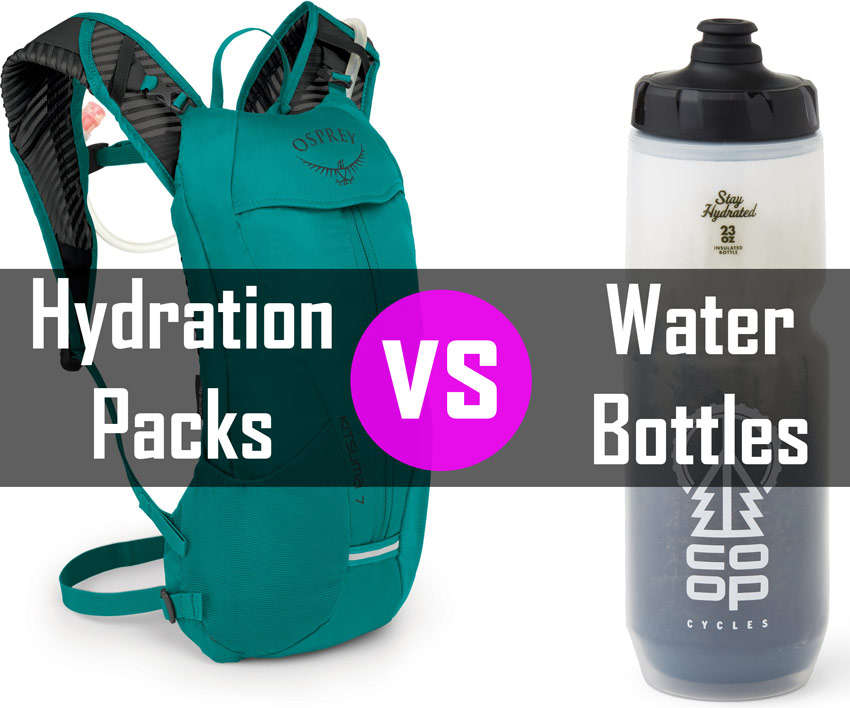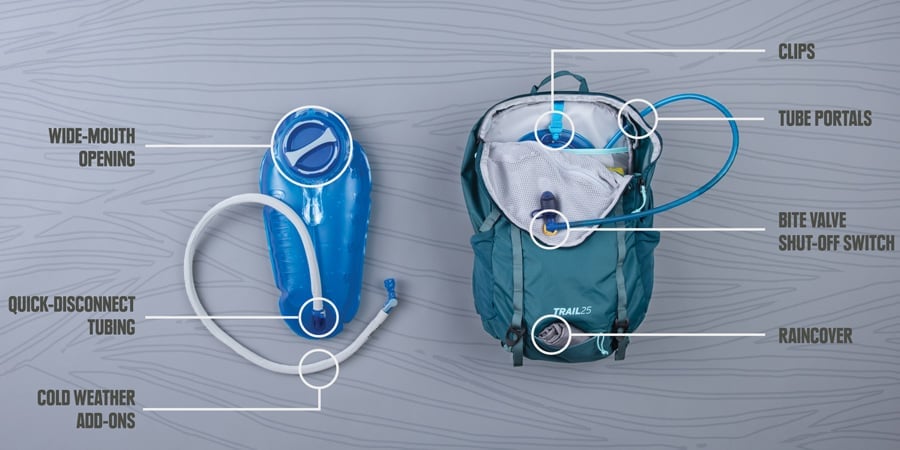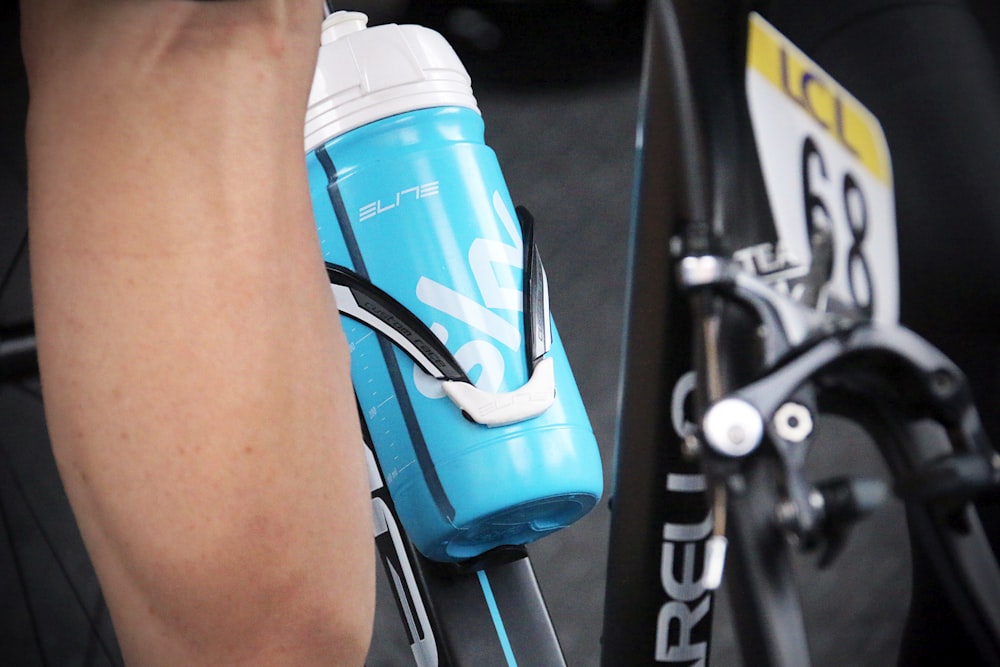Water bottles vs Hydration packs – Which is the Best Way to Stay Hydrated?

It is essential to carry enough water with you when you ride, whether you’re off-road cycling or road cycling. The two solutions available to cyclists are water bottles and hydration packs.
In general, mountain bikers favor hydration packs, while road cyclists choose water bottles (bidons) almost without exception.
Both have their unique pros and cons, and the one you choose will depend on a few things. Before making the choice, consider the following:
- Your preferences
- Style of riding (e.g. MTB or Road)
- Your bike’s geometry
- Budget
Why Proper Hydration Matters
We’re all guilty of forgetting to drink enough water at one point or another. During exercise, dehydration can happen quickly and easily if we aren’t prepared, especially when riding in hot weather.
The symptoms of dehydration include:
- Fatigue and weakness
- Muscle cramps
- Headaches
- Heat exhaustion/heat stroke
The average person should drink 16 ounces of water every 30 minutes of cycling. Hot weather, long rides, and high-intensity efforts can all increase these requirements. Electrolytes are also important. For rides longer than 1.5 hours, consider adding electrolytes to your water.
With all that in mind, let’s take a look at our options.
Water Bottles
As mentioned above, road cyclists pretty much exclusively choose bidons as their preferred hydration system. The best bike water bottles should keep your liquids cold, be light, easy to drink from, and BPA-free (see the end of the article for more on this).
Let’s take a look at the pros and cons of water bottles, and what makes them the top choice for road cyclists.
Pros
- Road bikes can usually fit two bottle cages in the main triangle, one on the seat tube, and one on the down tube. This makes it possible for riders to carry two 16 to 25oz bidons between their legs in the bike bottle cages.
- Bicycle water bottles can also be used for different types of liquids. For longer rides, sports drinks or powders with carbohydrates and electrolytes are necessary along with water so you can maintain hydration and energy levels. After your ride, you can easily run your bottles through the dishwasher or wash them by hand. With hydration packs, this is more difficult. Additionally, if you use your hydration pack for anything other than water, the pack is never the same.
- Road cyclists can usually fill their bidons mid-ride. Because road cyclists often pass through relatively urban areas, there are opportunities to fill bottles along the way. This makes it possible to carry less water if you know you can stop to re-fill during your ride
- Cycling water bottles are cheap. A bidon can cost anywhere from $3 to $30. This means they’re replaceable and can be used day-to-day as your regular water bottle
Cons
- Bidons are harder to drink from while you ride. They require the ability to ride safely with one hand on the handlebars in order to drink
- The amount of water you can carry in two bike water bottles is limited. On a longer ride, if you don’t know where you can re-fill, you may run out of water before you get the chance
- Mountain bike frame geometries limit the number of water bottles that can be carried. Full suspension mountain bikes especially make it difficult to have two water bottle holders
- Bidons can pick up dirt on wet roads or trails. This could make the bottle unsafe to drink from while moving, causing inconvenience for the rider
Hydration Packs

Mountain bikers generally lean towards hydration packs or ‘camelpacks’ for carrying their water. As mentioned above, it is highly unlikely you will see a road cyclist use one.
Some riders like to use a combination of a bottle with a hydration pack so they can bring a sports drink in the bottle.
Pros
- Hydration packs can be used hands-free. Cycling off-road on rough trails makes it more difficult to cycle using just one hand. This makes hydration packs very useful while riding on this type of terrain
- You can carry more water in a hydration pack. Bladder capacities range from 51 to 118oz (1.5-3.5 liters) The most common capacity of a hydration pack is 101oz (3L), over twice that of two large 25oz bike water bottles. This large capacity is important for off-road cyclists who will not encounter anywhere to re-fill during their ride. This means they often have to carry enough water for a whole day out on the trails
- You are able to carry other items in your pack. A good hydration pack will have space to carry all of your ride essentials for repair, plus some snacks and a basic first aid kit if needed
- The drinking tube stays clear of mud and debris. With the tube up at shoulder height, it’s unlikely that spray from the trail will contaminate the nozzle where you drink from
Cons
- Hydration pack water bladders are tricky to clean. Taking the bladder out and effectively cleaning and drying the inside is difficult, especially when compared to the simple water bottle
- The cost of hydration packs is significant when compared to bidons. Premium models can cost upwards of $200, and cheap versions may be ineffective and break easily. Replacing the bladder and tube parts is also pricey if they get damaged
- Riding with a pack isn’t as comfortable. Although well-built packs are quite stable and comfortable with a full load, they do require some getting used to. Poor quality packs can be uncomfortable, bouncy, poorly ventilated in the back, and hard to drink from
Are Plastic Water Bottles and Bladders Safe to Use for Cycling?
When choosing a bottle or water bottle or water bladder for cycling, it is important to ensure that the bottle is made with BPA-free plastic.
BPA a microplastic found in cheap plastic bottles that can leak into the water and result in health problems.
The best quality cycling water bottles and water bladders should not have this issue, so they are safer to use long-term.
Conclusion
By considering the points we have made above, you should be able to choose the right option to suit your hydration needs as a cyclist.
In the end, the most important thing is that you have enough water with you wherever you ride. The solution that makes your ride the most enjoyable is the best one for you.
Shop Hydration Packs on REI Shop Water Bottles (REI)



